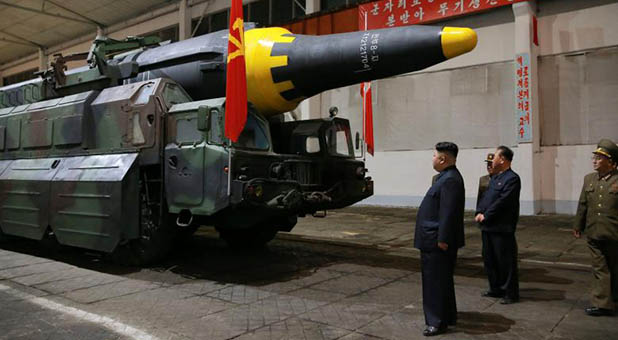This Is Why North Korea’s Latest Missile Launch Is So Concerning
Saturday marked another breakthrough in North Korea’s broad array of missile programs.
Pyongyang successfully launched a new system that could target U.S. military bases in Guam. North Korea is now one step closer to developing an intercontinental ballistic missile that could eventually threaten the continental United States.
Pyongyang announced that the Hwasong-12 intermediate-range ballistic missile flew 490 miles, but at an angle of 1,300 miles. Experts assess that, had the missile been flown at a normal trajectory, it could have reached 2,800 miles. Guam is 2,200 miles from North Korea.
The regime declared the missile can carry a “large-size heavy nuclear warhead.”
When first revealed in last month’s military parade in Pyongyang, the Hwasong-12 appeared to be a shortened version of the KN-08 intercontinental ballistic missile.
It may be a replacement or augmentation for the Musudan intermediate-range ballistic missile, even as it tests technologies for the KN-08 ICBM.
Saturday’s successful launch means Pyongyang’s quest to develop an intercontinental ballistic missile is progressing more quickly than previously thought.
This January, analysts greeted with skepticism Kim Jong Un’s claim that he had an ICBM in the “late stages of development.” There are far fewer skeptics today.
Saturday’s launch may have been the missile’s maiden test flight. While much has been made of North Korea’s numerous missile launch failures, those have been concentrated in systems still under development.
For comparison, the United States had very high failure rates in the initial development of its Redstone, Vanguard, Atlas and Titan missile programs.
Kim Jong Un has greatly accelerated the development and testing programs for all ranges of North Korea’s missile systems. During his five years in power, he has overseen three times as many missile launches as his father did during his 18-year reign.
This is the 10th North Korean missile launch this year.
The regime achieved several other notable successes in 2016-2017. This February, North Korea launched the new KN-15 medium-range ballistic missile—its first successful solid-fueled missile fired from a mobile launcher.
In August 2016, Pyongyang conducted a successful test launch of a submarine-launched ballistic missile. The missile traveled 300 miles, but with an unusually high trajectory. If launched on a regular high trajectory, the missile might have traveled over 600 miles.
In June 2016, the regime successfully flew a Musudan intermediate-range missile, also at an unusually high trajectory so as not to overfly Japan and to verify “the heat-resistance capability of warhead in the re-entry section and its flight stability,” including for strategic nuclear weapons.
Had the missile been flown on a normal trajectory, it could have traveled 2,500 miles, putting U.S. bases in Guam at risk.
Launch Is Litmus Test for US and South Korean Presidents
Since the U.S.-China summit meeting, President Donald Trump has praised on Chinese President Xi Jinping for his assistance on North Korea.
Trump walked back a campaign promise, declaring, “Why would I call China a currency manipulator when they are working with us on the North Korean problem?”
He also adopted a softer tone on Xi’s help with North Korea: “I believe he is trying very hard. … He is a very good man, and I got to know him very well. … I know he would like to be able to do something; perhaps it’s possible that he can’t.”
Trump even claimed that “nobody has ever seen such a positive response on our behalf from China.”
But China has repeatedly assured successive U.S. presidents of its resolve in pressuring North Korea, only to under-deliver every time.
Several Chinese actions lauded by the administration amount to less than meets the eye. After this weekend’s launch, Beijing responded by declaring that “all relevant parties should exercise restraint and do nothing to further worsen regional tensions.”
This is also North Korea’s first provocation since Moon Jae-in was elected president of South Korea on May 9. Moon, a left-of-center candidate, has criticized his predecessors and Washington, D.C., for an overreliance on sanctions and pressure tactics.
Instead, he advocates a return to the less conditional engagement policies of previous liberal presidents, including Roh Moo-hyun for whom Moon served as chief of staff. Roh’s term was marked by tense relations with Washington over policy differences on North Korea.
Moon sees economic engagement with North Korea as a means of bringing the north back to the negotiating table and eventually achieving “economic unification” of the two Koreas.
North Korea’s willingness to violate U.N. resolutions so quickly after Moon’s inauguration shows that the regime will not act any more benevolently to Moon than to his conservative predecessors.
In 2009, Pyongyang similarly disabused President Barack Obama of his view that the regime would act differently than it had under President George W. Bush.
Moon “strongly condemn[ed]” the missile launch and declared that while “South Korea remains open to the possibility of dialogue with North Korea, it is only possible when North Korea shows a change in attitude.”
More Pressure Needed
North Korea’s defiance of the international community was particularly embarrassing for China, since the launch occurred as their leaders were assembled in Beijing for the Belt and Road Forum.
If Beijing does not respond firmly to Pyongyang’s violation of U.N. resolutions, then Trump should impose stronger sanctions on Pyongyang as well as fully enforce U.S. laws through secondary sanctions on Chinese violators.
Moon now faces a dilemma on pursuing his intended engagement toward North Korea or defending U.N. resolutions.
While his initial response appears pragmatic, there are concerns in Washington that he will return to the one-sided provision of economic openness to Pyongyang without first demanding compliance with U.N. resolutions or the regime’s previous pledges to denuclearize.
Bruce Klingner is a senior research fellow for Northeast Asia at The Heritage Foundation’s Asian Studies Center who spent 20 years in the intelligence community working at the CIA and Defense Intelligence Agency.
This article was originally published at DailySignal.com. Used with permission.















































